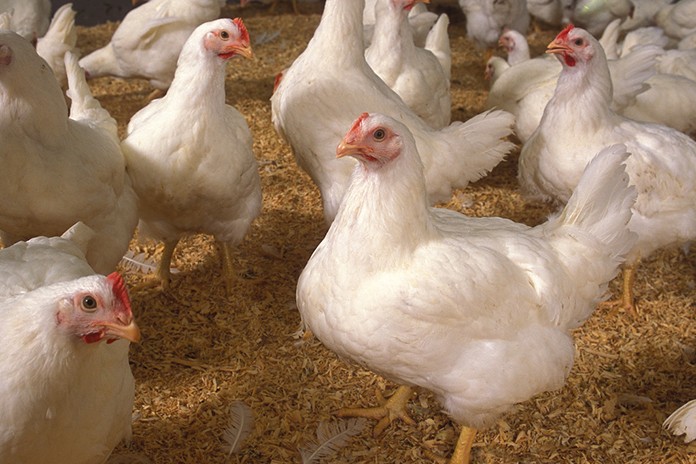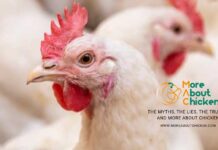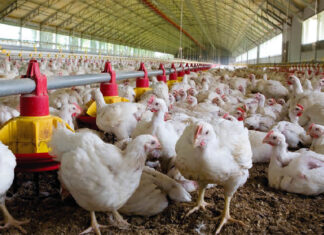
Broiler lameness is one of the top welfare issues facing the modern broiler industry. Despite the improvements in nutrition, health and genetics over the past decades, too many flocks end up with birds that are partially or completely immobile.
Chondronecrosis (BOC), novel Reovirus infections and spondylolisthesis (kinky back) are three infectious diseases currently resulting in lameness issues in the US. While Reovirus infections and Kinky Back can be devastating, the incidence is sporadic. BOC is more chronic and is seen in most flocks at some level. Assessing lameness on a large-scale broiler operation can be difficult and transecting walkthroughs may be a good alternative to gait scoring. Furthermore removing broilers prior to developing complete lameness is a critical practice for chicken growers and integrators must continue to encourage this practice.
Europe has focused more on the welfare aspect of lameness; however, the US industry is taking welfare more seriously as more major retailers, lead by food service companies, now require welfare audits. The incidence of birds with leg problems has been estimated to between 2 and 6%, but to my knowledge no large study of the US broiler industry has been completed in the last several years. A recent large study in the UK found that more than 27% of birds on average had poor walking ability and 3.3 % where considered clinical lame. Because of the many differences in management, genetics, nutrition and environment compared to North America, it is hard to infer that level of leg problems to the US broiler industry, but it does demonstrate that lameness is a real problem for broilers.
Non-infectious leg issues
Rickets is the classic nutrition caused leg problem and can be separated into two distinct types of rickets: hypocalcaemic and hypophosphatemic. Clinical rickets is not very common in the US due to improvements in nutrition and feed manufacturing. Most cases of field rickets are due to one type or the other of feed manufacturing error. The incidence of sub- clinical rickets is more difficult to assess, but still periodically appears with little or no specific causes. Sub-Clinical rickets has been linked to other conditions such as femoral head necrosis, osteomyelitis, bone fractures and other lameness related problems. My experience with sub-clinical rickets is it is often associated with “soft bones” normally observed around two to three weeks of age and detected on routine health surveys. These cases do seem to respond to water -soluble vitamins, so it has been hypothesized it is related to absorption of fat soluble vitamins. Some operations that are using coccidiosis vaccines, routinely run water soluble vitamin D as a preventative to rickets and soft bones. Phillips et al. has suggested that phosphorus requirements in current commercial strains to 10 days of age may be much higher than NRC or the industry is currently using.
Tibial Dsychondroplasia is a lesion characterized by a mass of avascular cartilage in the metaphysis of the proximal ends of the tibiotarsus and tarsalmetatarsis. It has long been associated with a fast growing broiler. The condition was once considered the major cause of lameness in broilers. In recent years the condition has been greatly reduced by selection against the condition by utilization of a lixiscope. However, TD is commonly seen in broilers flocks and is frequently associated with other deformities such as valgus-varus and rotated tibias.
Valgus-Varus deformities (VVD) are characterized by angular deformity in the long bones. It is frequently referred to by many common names such as “twisted legs” or “spraddle legs”. Primary Breeders have also been selecting against it through various methods; some highly technical and other phenotypic. However, VVD is still common in many US broiler flocks. VVD is detected in two specific stages. Varus has been found to occur very early (less than 2 weeks) usually due to the displacement of the gastrocnemius tendon. It may be related to the incubation or early chick handling. Valgus is a more common condition and occurs progressively later in the growout cycle normally starting to be noticed around 5 to 6 weeks of age and the condition worsens through market age. Rotated tibia is frequently included in the VVD condition, but it has different pathology than VVD. It is sometimes seen in conjunction with other leg problems such as TD and BOC. This connection points to some common links such as nutrition, malabsorption or genetics. Bone mineralization has been found to be low in severe VVD limbs. VVD including rotated tibia is the most common form of non-infectious causes of lameness in broilers based on my experience and is exacerbated by heavy processing weights of deboning plants. I find that visiting the thigh and/or drum deboning line of large bird processing plant is a good gaue to how much VVD is present in an area.
Infectious lameness
Bacterial Chondronecrosis (BOC) frequently referred to as Femoral Head Necrosis is considered to be the most frequent form of lameness across the US broiler industry today. BOC is thought to be initiated by micro-trauma to poorly mineralized columns of cartilage cells in the proximal growth plates of the leg bones. The condition normally starts to develop clinical signs after 5 weeks of age and worsens as more weight is added. The incidence has elevated in importance given the increase in bird size of the US industry relative to the rest of the world. A major portion of the US broiler industry produces broilers for deboning plants that approach or exceed 4.0 kg live weight. Most of these flocks are grown as straight run, so many of the males will exceed 4.5 kg.
Research from Dr. Robert Wideman’s group at the University of Arkansas has generated new interests in this disease that ranks as a constant in most broiler operations today. Using the wire floor model, Dr. Wideman has developed theories on the role of stress and immunosuppression in the development of BOC. It is thought that bacteria of various species translocation from the gastrointestinal tract or respiratory system and settle into the areas of the growth plate with poor blood flow. This model has allowed new research into preventative strategies for the condition.
Kinky Back (spondylolisthesis) emerged as a disease of importance in the US in 2008 and continues to be seen broiler flocks today. Affected birds become completely lame and unable to access feed and water. The only treatment is culling. This condition is associated with an abscess in the free thoracic vertebra (T4). It is distinct from the classical spondylolisthesis caused by a genetic condition, but carries the same common name. The abscess in the modern kinky back is normally associated with the isolation of the bacteria Enterococcus cecorum; but Staph. species can also frequently be isolated. Mortality is reported to be as high as 10-15% in flocks. Our experience shows that it frequently repeats on the same farms and houses. It has been combated by increased layout time, between flock cleanout or composting litter and disinfection.
Tenosynovitis or viral arthritis caused from Reovirus infections had been relatively rare in broiler flocks over the past 15 years and broilers are not frequently vaccinated with the common strains. Recently a novel strain emerged in the US broilers industry and available commercial strains of reovirus vaccine are not providing protection. I have personally had very little experience with Reovirus in broiler flocks until this past year. At of one our operation reports emerged about severe leg problems including soft bones and leg being completely stuck out to the side. The affected flocks were traced back to specific breeder flocks in one area. In the worst affected flocks up to 40% of the birds had to be culled. Other integrators in the areas had gone through a similar problem a few months earlier. In the affected breeder flocks, virus is shed for 6-8 weeks normally around peak production and no clinical symptoms are present in the hens. Economic losses in the affected broilers flocks are large as an increase in mortality and condemnations increase during the time the virus is present. Some integrators have started moving chicks from breeder flocks identified as positive into small bird programs to limit the losses.
Perspective of a broiler integrator
The perspective on lameness from many broiler integrators has changed over the last 10 years from concern about how many birds were being lost to leg problems (economic loss) to concern about the impact on overall welfare and product quality (such as IP). My company has been on the forefront of animal welfare in the US and was the first broiler company to receive the Humanely Raised Process Verified Program from the USDA. We have learned a lot from acquisition of a smaller company that specialized in Organic and Antibiotic Free chicken production. They complied with some of the most rigid welfare practices in North America. These practices included growers keeping detailed records of birds culled from leg abnormalities and doing leg assessments at key times during the flock. Daily culling lame birds using proper euthanization techniques was not just encouraged; it was required as part of the contract and growers that did not comply risk losing it.
Most, if not all Integrators, encourage euthanization of lame and unthrifty birds. It is in their best interest since these birds will typically end up being condemned in the plant. The act of culling lame birds however can be tedious and difficult. The average age of poultry growers continues to rise and the physical demands of culling older birds can be taxing. Since lameness frequently develops in the last weeks prior to market, many growers may see culling as eating into their profit. This reluctance to cull is not limited to the US. Knowles et al. in a large scale assessment of lameness in UK broiler flocks noted that more than 3% of the birds classified as lame according to the UK gait method persisted despite strict protocols for culling birds above a gait score of 3.
Lameness metrics
One reason for the absence of large scale studies of lameness incidence in the US is the difficulty in measuring it. The 5 scale gait score has been widely used and reported on in studies in the EU. In this system a score above 3 is considered lame. The National Chicken Council Welfare guideline (NCC. 2010) has a simpler 3 (0-2) point scale and considers that for broilers, even perfectly normal birds may appear ungainly. These methods may work well for a research program when looking at individual birds is desirable, but in a large scale operation these are not very good methods to assess the overall flock leg health. A recent publication from Spain demonstrated that transect walks through the broiler house has good potential as a routine monitoring tool. Our company routinely uses a similar method to assess lameness incidence in production houses. It counts the numbers of birds affected by different category of lameness by walking through designated areas of the house. We realize that the system is not perfect with some intraobserver variation that will occur with most any system.
Control measures
Lighting, including photoperiod, intensity and wavelength, is one of the most important, yet poorly understood aspects of poultry husbandry. Many top growers closely guard their own lighting program even locking the control box to protect their “secret”. Recent work by Dr. Classen’s group at University of Saskatchewan has demonstrated the affect of reduced photoperiod on performance and leg abnormalities. Reduced light periods of 14 and 17 hours was found to significantly improve gait scores versus 20 and 23 hours including infectious related issues. The most basic light program for many growers is 23L:1D and many poorer performing farms actually perform better on this type of program. However, we have recently implemented programs with longer dark periods and feel we’ve seen benefits to both welfare and performance. Moreover, more growers are implementing the dark period at night to eliminate light from illuminating the house from the ventilation system.
Light Intensity has been shown to have lesser effects on welfare than photoperiod. However, the US industry as a whole at least believes in benefits of lower light intensity (1-5 lux) in the period after brooding. Much of the US industry has progressed to enclosed housing to provide improve environmental controls. Increases in Infectious Process in the processing plant and the resulting downgrades have driven growers to reduce intensity. While I have little evidence that this practice affects leg health either way, it does make it difficult for growers to interact with and assess the flock. One welfare program in which we participate requires light intensity bright enough to read a newspaper and this provides enough light to clearly obverse the flock.
Work from North Carolina State University has shown the importance of proper incubation temperature and chick transport. These researchers showed that incubation and transport stress negatively affected the incidence of leg abnormalities such as twisted legs and crooked toes. Many hatchery professionals now routinely use chick rectal temperatures to monitor incubation parameters. The importance of proper chick transport is still an overlooked area. Chicks are frequently are kept in holding rooms for several hours prior to placement. Producers should routinely monitor rectal temperature throughout the transport vehicle at placement to determine whether overheating occurs is occurring.
As discussed above, the translocation of bacteria from the GI tract or respiratory system is thought to be a major contributor to BOC. Wideman et al., (2012) found that a probitoic regime significantly reduced the incidence of BOC in the wire-floor model. This highlights the importance of maintaining intestinal health to overall health. Many integrators in the US still routinely use antibiotic growth promoters; however, a few companies, including ourselves, have removed all growth promoting antibiotics from broilers and only treat when a flock becomes ill. Preventative therapies such as probitotics, yeast cell walls and other “natural” products are now frequently used in feeds, but there is general confusion around their actual affects.
The goal of producing broilers is to produce meat for consumption and broilers have been developed for appetite to consume feed and fast growth. Lameness is frequently cited as having a direct link to fast growth. While it is true that many slow growing breeds have fewer leg problems, many faster growing flocks have few lameness issues and many slower growing flocks do have these issues. Many restrictive feeding techniques have been tried and early restriction has shown some success (Bradshaw, 2002). Feeding a low nutrient density diet may reduce overall leg problems, but the loss in productivity including key economic drivers like feed conversion and yield are greatly affected.
From the Australian Poultry Science Symposium
















